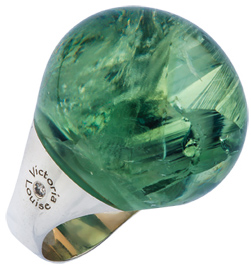|
Colored Gemstone
A Gem of Many Names
Green quartz is known by several names, including prasiolite, vermarine and green amethyst.
By Sheryl Jones

| | Victoria Louise Design |
Green quartz is commonly known as prasiolite, the name derived from the Greek word meaning “leek stone,” which describes the gemstone’s pale green color. Its popularity owes much to the fact that even in its lighter shades, the stone’s color has a lot of depth. Designers also like that it is available in large sizes, is durable and affordable.
While many people in the industry still refer to the stone as green or greened amethyst, those terms are a misnomer because amethyst is defined only as violet or purple quartz. The name probably was coined because most prasiolite on the market is a treated amethyst, in which the green color emerged as a result of heat and radiation treatments. Mike Wang of Wonder Sources, Inc. , a 30-year gemstone wholesaler, offers another explanation as to why the name became widely used. “I think the gemstone industry may use the term green amethyst to help people understand it is a natural, semiprecious stone, not synthetic,” he says.
“When it first came on the market, suppliers offered it as natural green amethyst. As I got to know more about the stone, I learned this was not the case because it was actually a treated stone,” says Amar J. Jain, president of Fine Gems NY, Inc. “In the beginning, they didn’t tell you that,” echoes Wang.
Quartz is one of the world’s most abundant minerals, making up about 12 percent of the earth’s crust. The white or colorless variety is most common.
Natural green prasiolite does exist; however, it is very rare. It is formed as a result of a combination of heat and radiation naturally occurring within the earth. Small deposits of this naturally formed green prasiolite have been found in Canada, Namibia, Poland, Brazil and near the California and Nevada border in the United States.
Since natural prasiolite is so rare, almost all of the prasiolite on the market is treated amethyst that contains ferrous iron. When heated, amethyst usually turns yellow — the most common, marketed as citrine — orange or brown due to its iron compounds. However, amethyst that contains ferrous iron will change to green after being treated. Most of this quartz material containing ferrous iron comes from the Minas Gerais area and the Amazon, both in Brazil.
Gemstones are often treated with radiation and heat to enhance their color. For bigger companies that are treating larger volumes of gemstones at a single time, have substantial inventory and the sophisticated equipment required, the radiation process can take place in one of two ways: either in a nuclear reactor that is neutron bombardment or in an accelerator that is electron bombardment. While these methods are more expensive, the advantage is that the color achieved is often stronger. These processes are regulated by the Nuclear Regulatory Commission (NRC).
The more popular way to produce prasiolite — and simpler because it does not involve NRC regulation — is by gamma ray exposure in a cobalt-60 irradiator. In this method, the stones are placed in a thick-walled container in which gamma rays move the electrons from their normal positions within the stone. The color change happens as a result of the new electron formation and the charge of the atoms around them. After the treatment, the material is heated so that the color doesn’t fade.
Prasiolite has been on the market in large quantities for about 20 years. Approximately three to four tons a year are produced worldwide. The annual volume of amethyst production, by comparison, is double that amount. According to Mykel Rieth, gemstone cutter and owner of R Gems, Inc. in New York City, prasiolite was found by accident. “Some manufacturers in Brazil were treating amethyst to produce lemon citrine when all of a sudden the color happened,” he says. The new shades filled a niche in the market for a light-hued and affordable green stone. “There was no other stone we could find in that shade range, so it became very popular,” says Jain, who has been selling the stones for about nine years.
Manufacturers and designers, including David Yurman, Tacori and Tiffany & Co., use prasiolite in their collections. Noreen Paris, owner and designer of Victoria Louise Design, says the grade of material she uses is beautiful and has strong color. “The inclusions enhance the beauty of the stone,” she adds, “and allow me to sell my rings at affordable price points.” Depending upon the size and clarity, prices for prasiolite range from about $1 per carat and up for very light, icy green stones with inclusions to as much as $15 per carat for stones with intense green color.
Paris says that unlike some other gemstones, prasiolite is flattering to all skin tones and shades of green are a current fashion favorite, making it an ideal choice for designers like her who want the gemstone, not the metal, to be center stage for a stylish clientele.Article from the Rapaport Magazine - January 2015. To subscribe click here.
|
|